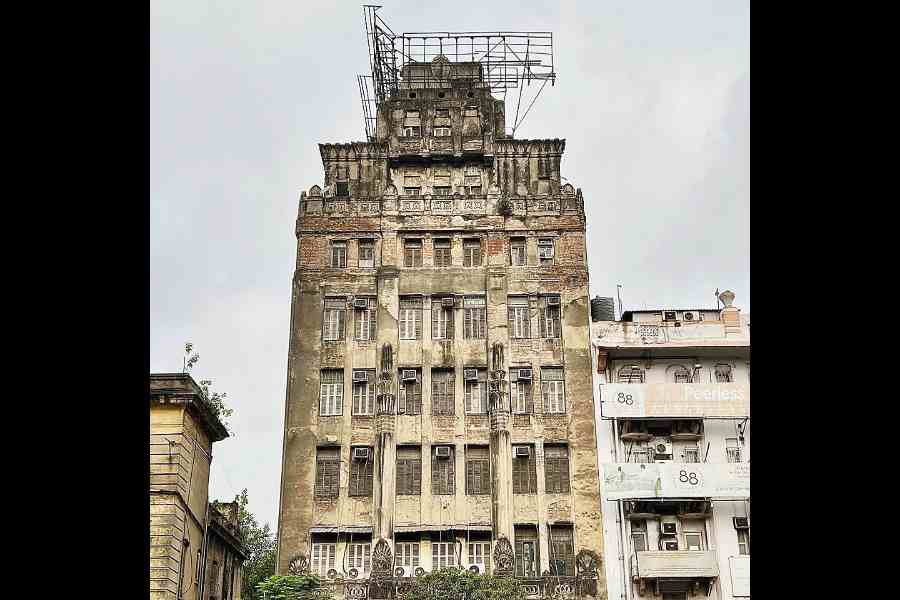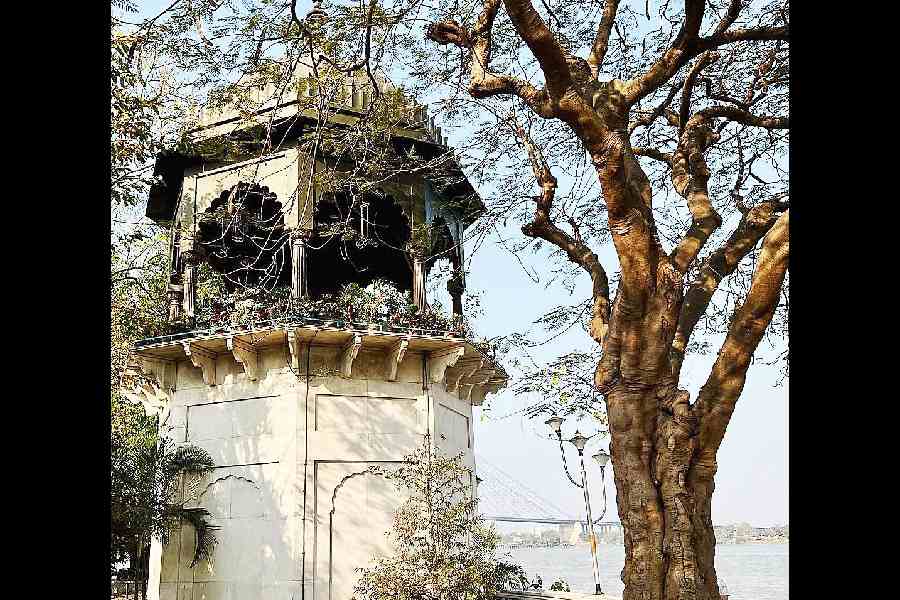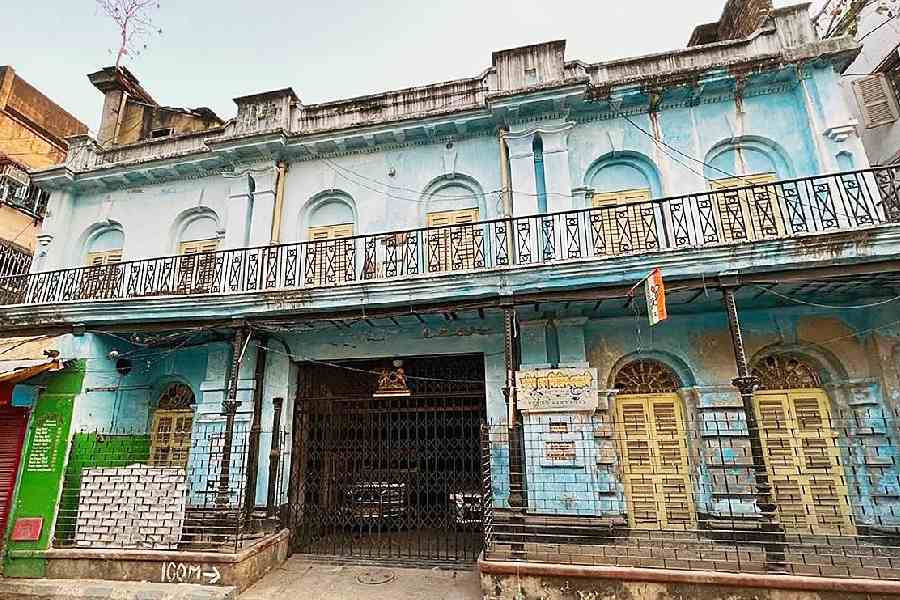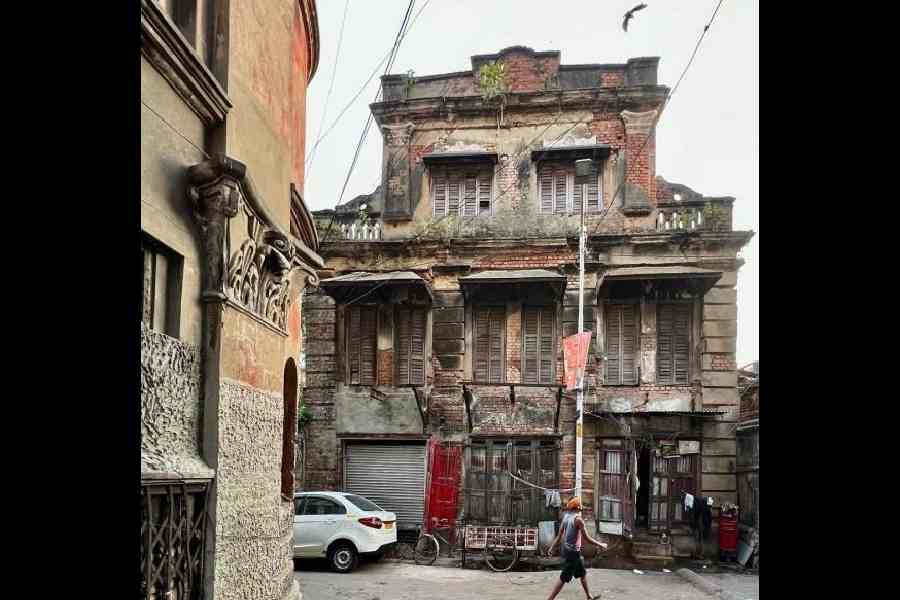What makes a Calcutta morning special? Long walks during which different facets of the city can be discovered (and rediscovered). For me, it’s about taking pictures in ProRAW mode on the iPhone or shooting ProRes on the new iPhone 15 Pro Max because some of these pictures need to be immortalised. Here are five stories that I have stumbled upon.
Bohemian rhapsody by Shibram Chakraborty
No, the popular Bengali writer and humorist didn’t have Freddie Mercury’s vocal skills but he did lead an unconventional life. The maze of humour readers often find themselves in Shibram’s books is equally applicable if you were to search for the man’s address in north Calcutta.
Though his father, Shibprasad, lived in Murshidabad, Shibram grew up in the royal family of Chanchal in Malda. But the only royalty he had experienced was the royal treatment readers gave his literary creations.
Soon after learning about the Swadeshi movement in school, he wanted to be part of the process and was jailed. It was also in Chanchal that he met Chittaranjan Das and influenced by Deshbandhu’s words, he decided to move to Calcutta. It’s said that on arriving Deshbandhu had asked Bipin Behari Ganguli to take care of Shibram, who was given Rs 100 to buy clothes, educational books and so on. Shibram being Shibram went over to a restaurant and had a good meal there.
There are a lot of stories about him. The creator of the good-natured brothers Harshabardhan and Gobardhan is said to have borrowed money from a kabuliwala but the lender couldn’t find his address because not even a plaque exists outside 134 Muktaram Babu Street, a mess bari or living quarters for men. Most people in the neighbourhood don’t know its existence, so it’s best to ask for directions at a local grocery store.
There’s nothing much to see inside but if you are feeling curious, do visit in the evening. It’s said that he used the walls of his room as a calendar. There was also a serious side to the author, which you can explore in Iswar Prithibi Bhalobasa and Moscow Bonam Pondicherry.
Perhaps this weekend you can revisit the Ritwik Ghatak film Bari Theke Paliye, which is based on a Shibram Chakraborty novel. Or you can take your camera down to 134 Muktaram Babu Street to find the mess bari.
GI Joe and City of Joy
This is the Tower House, a stone’s throw from Victoria House. Constructed around 1937 by Sudlow, Ballardie and Thompson, the Art Deco structure has a feel of the Empire State Building and it was once a very important part of history that we don’t often talk about.

Singapore fell to the Japanese invasion in February 1942, sending bells ringing about the security of Calcutta. American soldiers or GIs started pouring in to prop up the British. For the 150,000-200,000 GIs in India, the country came across as a cultural shock. Hollywood had sold them the idea of maharajas and palaces but reality was grim.
Their handbooks asked them to steer clear of politics and the Office of War Information had initially chosen journalist-author Robert Aura Smith as the head of information operations in India. Smith took the help of J Walter Thompson or JWT, the New York agency with offices in India, to launch a campaign about how America always fights for freedom.
In Calcutta, GIs were seen all over Chowringhee and Dalhousie Square, at places like the American Red Cross Burra Club, Grand Hotel and Firpo’s. The great jazz pianist Teddy Weatherford felt at home playing the piano at the Grand, entertaining GIs. He died here of cholera on April 25, 1945.
One man who documented this era in-depth was military photographer Clyde Waddell (later press attache to Lord Mountbatten). He captured not just the presence of GIs in the city but also how the Bengal famine of 1943 affected people.
Coming back to Tower House, in April 1943, the US government set up a reading room on the third floor of this house to dispense war information, marking the start of the Calcutta American Center Library. To meet the growing interest in American studies the library expanded its collection in 1947 and shifted to a small apartment on the first floor of Esplanade Mansions. It started its free reading service in 1950. The address changed a few more times before reaching its permanent spot on Chowringhee.
Walk along the Strand
Lord Ellenborough’s tenure as Governor-General of India lasted only 2.5 years (February 1842 to June 1844), mostly marked by uprisings and wars.
He thought there was a loss of British prestige in India and so was eager to have a show of power, like what he did with the Gwalior campaign, which took place on December 28-29, 1843. A large British army was placed under Sir Hugh Gough. Meanwhile, General Grey took the lead, threatening the Gwalior territory from the south while Gough led his men down from the northward. General Grey quickly reached Panniar on December 28. The next day, the British army was face to face with the Marathas. The losses at Maharajpoor were severe on both sides.

After being praised by the Duke of Wellington, Ellenborough thought the victory needed to be immortalised, so he commissioned the Gwalior Monument on Calcutta’s Strand. It was ultimately built in 1847 in memory of the officers and men who fell in the 1843 battle. These are people who fought for the British. The structure is built of brick, faced with marble and surmounted by a metal dome supported on columns, manufactured by Jessop & Co., from guns taken from the “enemy”, William H.G. Kingston mentioned it in his 1863 book.
Geoffrey Moorhouse in his book, Calcutta, tells us some of the names that have been immortalised here: “Sepoy Ganga Din and Sepoy Juggernauth Misser and Naick Runmust Singh and a variety of Bombardiers, Roughriders and Farriers, led by a Major-General C.H. Churchill, are commemorated for a battle they fatally won in 1843.”
The structure — lovingly/sarcastically called ‘Pepper Pot’ — has been immortalised by none other than Desmond Doig in his sketches. Doig was the force behind JS or Junior Statesman, the erstwhile cultural magazine of TheStatesman.
Can you enter the monument? No. But couples (and pigeons) certainly coochie-coochie coo around it while drinking in the view of the Hooghly.
Waltzing to Balsara’s music

Akrur Dutta Lane. I had only heard about this place from my father who used to, well, “hang around” to listen to V. Balsara. In fact, it was through my father’s record collection that I came to appreciate his music.
Anyway, it was March 24, 2005, when I heard that the maestro had passed away at his nephew’s residence in Ballygunge Park but my interest always had been in Akrur Dutta Lane. As with every newspaper reporter, the evening was a blur but what remains — and will forever remain — is his music.
Balsara was a man who could bring any musical instrument to life. He was a genius. But it wasn’t music all the way in the early part of his life. His early years saw him work at a typewriter as a steno-typist and then he wanted to devote time to marine engineering.
Thankfully, in 1937, he was asked to fill in as a pianist and he came away richer by Rs 12 for six songs and an offer to be the assistant to music director Ustad Mushtaq Hussain Khan.
What I have always liked most about his music was the unique style with which he played the harmonium and the piano. On the track Awara Hoon, he created the accordion sounds on a harmonium.
It was only in 1953 that he came to Calcutta for a programme at Hindustan Park. He soon made the city his own. And what about the univox? Try listening to the LP Sounds of the Univox. Thank you maestro. You are not forgotten.
Silence is golden

Valentine’s Day will soon be upon us but let’s look beyond cliches. Walking through the ordinary gates of South Park Street Cemetery in Calcutta, lies a moss-covered world into which we come and go but there are those who have had to stay awhile. Walking for a couple of minutes brought me before the grave of Rose Whitworth Aylmer, like it did the first time, two decades ago.
Here’s is the story of love unfulfilled, dying at the age of 20 or soon after arriving in India. The daughter of Henry, fourth baron of Aylmer and niece of Earl Whitworth, was loved by the poet Walter Savage Landor.
They met on the Welsh Coast, near Swansea, around 1797. He was 21 and she, 17. It wouldn’t hurt the eyes to imagine them walking on the silky beaches, speaking sweet nothings overheard only by the rumbling waves. She offered him a story by Clara Reeve and he gave the world ‘Gebir’.
Love works in mysterious ways. The death of her father was followed by her mother’s remarriage with Howell Price. Though the marriage had taken place before the young couple had met, in 1798 she was sent out to Calcutta to join her aunt, Lady Russell, wife of Sir Henry Russell, at a house on what we know as Russell Street.
She died in March 1800 and the news soon reached Landor. He wrote an elegy, which was inscribed on her grave.
Ah what avails the sceptred race,
Ah what the form divine!
What every virtue, every grace!
Rose Aylmer, all were thine.
Rose Aylmer, whom these wakeful eyes
May weep, but never see,
A night of memories and of sighs
I consecrate to thee.
A companion to these lines is Landor’s poem, Abertawy.
Where is she now? Call’d far away,
By one she dared not disobey,
…
Where Ganges rolls his widest wave,
She dropt her blossom in the grave;
Her noble name she never changed,
Nor was her nobler heart estranged.
